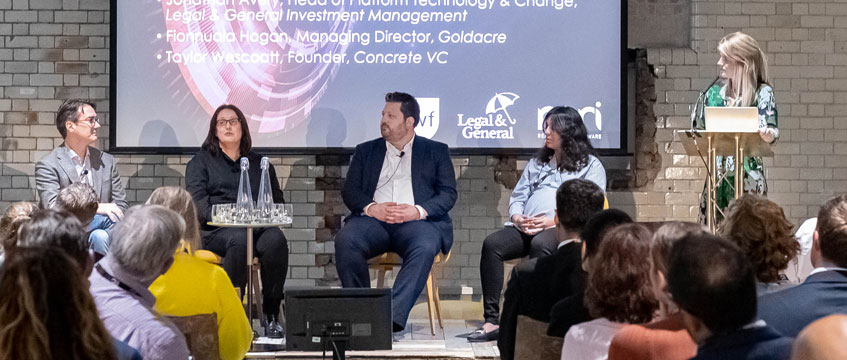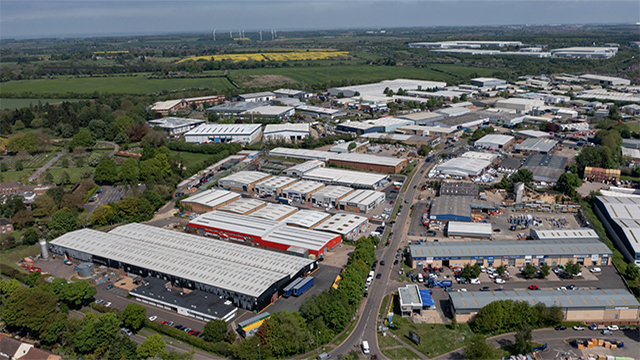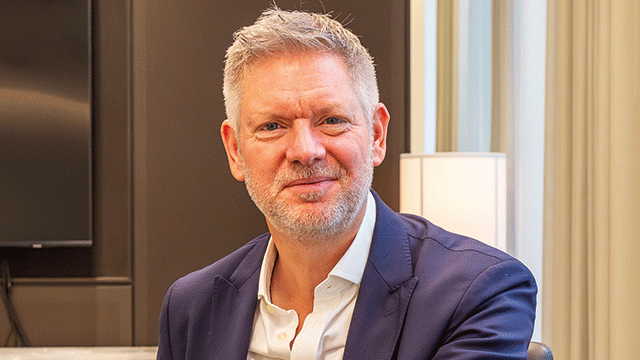Tech Live: What do dinosaurs and proptech have in common?
One famous scene in the film Jurassic Park has become a business mantra of sorts for Wordsearch Place director and founding partner William Murray.
Dr Ian Malcolm (played by Jeff Goldblum) is sitting in the middle of a roundtable discussion at the beginning of the movie, listening with growing frustration to Jurassic Park owner John Hammond (played by Richard Attenborough) and his team as they outline how they could unleash their wondrous creation onto the rest of the world.
Hammond turns to Malcolm, proudly claiming: “Our scientists have done things that nobody has ever done before.” The mathematician replies in exasperation: “Your scientists were so preoccupied with whether or not they could, they didn’t stop to think if they should.”
One famous scene in the film Jurassic Park has become a business mantra of sorts for Wordsearch Place director and founding partner William Murray.
Dr Ian Malcolm (played by Jeff Goldblum) is sitting in the middle of a roundtable discussion at the beginning of the movie, listening with growing frustration to Jurassic Park owner John Hammond (played by Richard Attenborough) and his team as they outline how they could unleash their wondrous creation onto the rest of the world.
Hammond turns to Malcolm, proudly claiming: “Our scientists have done things that nobody has ever done before.” The mathematician replies in exasperation: “Your scientists were so preoccupied with whether or not they could, they didn’t stop to think if they should.”
Murray says the industry should take heed of Malcolm’s words in its approach to adopting technology. “It’s not just about what we could do,” he says. “We can all sit in fantastic, exciting brainstorming meetings and say, ‘wouldn’t it be great if…’, but the important question is whether we should do it, or why we should do it, and what value it is going to bring in the long term.”
The Wordsearch Place director was speaking at one of three panel discussions held at EG’s Tech Live event, hosted at U+I’s 7A Howick Place in London’s Victoria. His comments were fitting, considering the theme of the event: Hype to Execution.
Speakers cast light on what stage proptech was at in its evolution, and how to cut through the noise to focus on how best to facilitate change in the industry.
Money maker
It was Murray who kicked off proceedings, alongside fellow director and founding partner David Twohig.
The two were discussing how to balance cultivating creativity in tech start-ups while also making an all-important profit.
Murray and Twohig are experts at this balancing act. Twohig, former chief development officer and head of design and placemaking at Battersea Power Station, spent 10 years honing his understanding of “what it is between the buildings that brings value”, to squeeze the benefits out of the multi-billion-pound project.
Murray, meanwhile, has spent 22 years at Wordsearch Place, providing consultancy services to clients on how to successfully implement placemaking.
Although Twohig is considered the “capitalist” and Murray the “idealist” in their partnership, both say that sharing and believing in the same vision is fundamental to success.
So what is the key to creating successful places? “Real estate has thought about buildings being for ‘forever’,” says Murray. “But actually, it’s forgotten about people. If people are happy, if people want to go places – and that means all people – then places will be better, and places will be more profitable.”
Wordsearch Place has been successful in this craft, working on projects including the Shard, Nine Elms, Battersea Power Station and One World Trade Center in New York.
[gallery type="slideshow" link="none" size="full" ids="1000784,1000794,1000782,1000781,1000786,1000783,1000785,1000787,1000789,1000788,1000780,1000791,1000792,1000790,1000773,1000793"]
A listening ear
Key to the company’s rise has been a combination of passion and constantly listening to what people want from the buildings and spaces around them. “The answer is always in the room,” summarises Murray. “And if it’s not in the room, you’re not going to be able to deliver it.”
The conversation around placemaking, as well, has gathered speed as property tries to understand how it can rejuvenate a failing high street, says Murray. Understanding how to revitalise and change the functionality of whole town centres is something that placemaking can help with, he says.
But, of course, this all requires developers in charge of creating these schemes to buy into the idea of the benefits of placemaking. And as the sector knows, persuading developers, who are predominantly driven by the bottom line, to commit to this can be a challenge.
Twohig says there are two types of clients – those who “ultimately get it and it’s part of their business” and the developers who “you know you could do so much to help and actually shift the dial. And they’ll probably be the ones that will never sort of get it.”
He concedes that a growing number of developers are starting to shift into the “I get it” camp, but in order to help this movement, more data and proof points need to be collected as evidence of the benefits of investing in placemaking.
Tech: where are we now?
Wordsearch Place may have found success in the real estate world, but has the proptech sector in general managed to muscle into the industry as easily?
Those speakers on the panel discussing the digital transformation of real estate agreed that property has progressed in adopting tech, but is still at the start of its digitisation journey.
Fionnuala Hogan, managing director of Goldacre and co-founder/head of RElab, says the industry is at an “interesting inflection point” in adopting tech. She says more companies are starting to embrace it, but implementing these new technologies into the core of businesses is proving to be slow.
This is because tech involves embracing change, and change can be difficult, says Hogan. “If it was just a question of putting a platform or a process in place then that would make it a lot easier,” she says. “But it also actually needs us to change how we work together, how we work with partners who might be quite different from us and how we think through things.”
Progress may be needed, but Concrete VC venture partner Taylor Wescoatt says real estate is committed to this change. “We work with a whole bunch of partners, and they all absolutely want to change,” he says. “They are up late at night thinking about how to do that, and they’re eager to explore all opportunities to do that too. I think that’s a really good sign.”
We can all sit in fantastic, exciting brainstorming meetings and say, ‘wouldn’t it be great if…’, but the important question is whether we should do it, or why we should do it
William Murray | Wordsearch Place
Although real estate may be showing enthusiasm for adoption, it needs help in doing so, says Travtus founder and chief executive Tripty Arya. In fact, she says property companies should not be the ones overseeing tech strategies and programmes. “I don’t think real estate has the skill set in house at this point,” she says. “Most companies don’t.”
In order to make real progress, property needs to ditch its risk-averse attitude to investing in tech. “In real estate, the tendency is to go for the vendors or the providers that you understand,” she says.
Vice versa, Wescoatt argues that proptech companies “need real estate people badly” in order to better understand the industry.
In terms of what the future of tech in real estate looks like, Jonathan Avery, head of technology and change at LGIM Real Assets, says the industry will need to recruit more people skilled in data crunching, as the use of data to monitor and manage assets is set to “increase exponentially”.
He says that, even now, it is common to see 300 data points around a standard property lease – and this is only set to increase. “We’re looking at all these new data sets to try and drive insight,” he says, adding that translating this data into actionable strategies for landlords is “going to be the exciting challenge of the next five years”.
CVs at the ready
The relationship between tech and property was a recurring theme at this Tech Live event, with the last panel dedicated to debating why a growing number of real estate professionals are moving into the tech sector.
Vishal Shah, investment associate at U+I, says the industry has moved past the mentality of “if it isn’t broken, don’t fix it” towards tech adoption in the industry, and has recognised that tech can enable competitive advantage. He says this has influenced the shift in more people moving into tech from the real estate sector.
But DWF Law principal consultant Ed Hunt says that it is essential for real estate companies to cultivate innovation within, through encouraging creativity. This, he says, is key to progression. “What we need to do is understand how corporate creativity works,” says Hunt.
“We need to embed that within our organisations… that is a skill gap. We don’t have enough people who are creative or have the tools to be creative in a methodical manner, and that’s something that we have been looking at.”
James Morris-Manuel, vice president of EMEA and managing director at Matterport, agrees. He adds that property’s slow adoption of tech could be down to market complacency.
“The industry has had it relatively good for quite a while, and it’s a slow market,” he says. “It’s not like the fintech market, which has had technological change because they recognised that technology can make you more money.
“In the property industry, there are a lot of variables. There’s a fair amount of emotion within the industry, as well as how decisions are made. So that altogether has definitely, I think, slowed the adoption of technology in the industry to date.”
Dinosaurs and proptech
Proptech is at an exciting point in its journey, but it is important to cut through the hype surrounding the sector and understand what is critical for keeping real estate moving with the times.
And, as Murray pointed out, the sector would do well to channel lessons from Jurassic Park, and pause for thought over exactly which technologies should be implemented, rather than blindly developing them all.
To send feedback, e-mail lucy.alderson@egi.co.uk or tweet @LucyAJourno or @estatesgazette
Photographs by Ed Telling Photography











